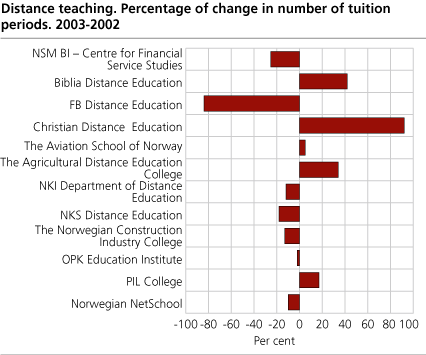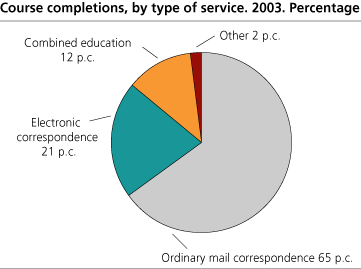Content
Published:
This is an archived release.
Subject preferences differ according to gender
12 independent distance teaching institutions reported a total of 20 000 course completions in 2003. In the total number of participants, gender distribution was almost equal, but gender differences were considerable concerning choice of subjects.
The most popular courses, when counting both sexes were social sciences, 5 000, transport and communication, 3 500 and business and ICT, 3 000 course completions.
Patterns of gender differences can still be observed concerning choice of subjects. Within transport and communication subjects and science, industry and technical subjects male participants accounted for 90 and 80 per cent respectively. Women, on the other hand, were dominant within aesthetic subjects and handicraft and within health, social and sports subjects accounting for more than 90 per cent in all. Female participants were also in majority within humanities, philosophy and ethics, social sciences and business and ICT subjects.
Continued decrease in activity during 2003
In total there was a considerable decrease in course completions and tuition periods from 2002. In 2003 there were about 9 000 fewer participants and more than a million tuition periods less compared to 2002.
Three institutions, FB Distance Education, NKI Department of Distance Education and NKS Distance Education, accounted for 95 percent of the decrease in participants from 2002. In spite of total reduced activity, five institutions experienced an increase in both course completions and tuition periods.
... most dramatic at upper secondary school level
The most dramatic decrease during 2003 was for courses at upper secondary level, which had a 40-percentage reduction in number of tuition periods from 2002. The number of tuition periods at upper secondary school level has been more than halved since 1999. Of all tuition periods specified with level in 2003, upper secondary level accounted for less than 50 per cent. The majority of tuition periods were at university and college level.
Electronic correspondence more frequently used
Electronic correspondence was more frequently used as the means of communication between participant and institution compared to previous years. In 2003, about 20 per cent of all participants chose electronic correspondence as the means of communication, compared to 13 per cent in 2002. The majority of all course completions however, about 65 per cent, preferred ordinary mail correspondence.
Tables:
- Table 1 Tuition periods, by institution and level. 2003
- Table 2 Course completions, by independent distance teaching institution and sex. 2003
- Table 3 Course completions, by age and sex of the participant and subjects. 2003
- Table 4 Course completions, by percentage females and age of the participant. 2003
- Table 5 Course completions, by age, sex and county of the participant. 2003
- Table 6 Tuition periods, by level. 1999-2003
- Table 7 Course completions, by type of education and age of the partcipant. 2003
- Table 8 Number of course completions, by examination and level. 1998-2003
This page has been discontinued, see .
Contact
-
Statistics Norway's Information Centre
E-mail: informasjon@ssb.no
tel.: (+47) 21 09 46 42



